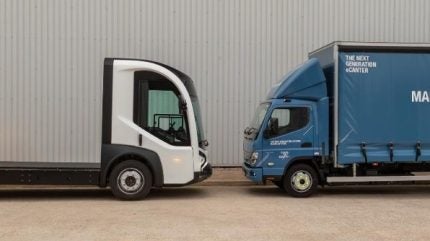
Japan’s Mitsubishi Fuso Truck and Bus Corporation (MFTBC) announced it has signed a memorandum of understanding with Israel’s automotive technology company REE Automotive Ltd to collaborate in the development and verification of Software Defined Vehicle (SDV) and X-By-Wire (XBW) technologies for next-generation commercial vehicles.
SDVs refer to next-generation vehicle architectures where key functions and performance are primarily controlled and updated through software. MFTBC sees SDVs as next-generation vehicles offering greater flexibility and scalability, extended vehicle lifespans and reduced total cost of ownership, bringing significant long-term value to customers.

Discover B2B Marketing That Performs
Combine business intelligence and editorial excellence to reach engaged professionals across 36 leading media platforms.
XBW technology replaces traditional mechanical linkages with electronic controls, enabling steering, braking, acceleration and other driving functions to be managed via sensors and electrical signals. This technology is expected to not only enhance vehicle safety and operability, but also contribute to reduced vehicle weight, improve fuel efficiency, and help in the deployment of advanced driver assistance (ADAS) and autonomous driving systems.
MFTBC confirmed that the two companies have launched a joint initiative to explore and validate the integration of XBW and SDV technologies, with the aim of “unlocking new possibilities for next-generation commercial vehicles by delivering optimized modular architectures with greater design flexibility, excellent controllability and advanced safety features, all while reducing costs to end users.”
MFTBC and REE have agreed to jointly build a Proof of Concept (PoC) vehicle within one year, integrating the technologies of REE’s P7-C EV chassis and MFTBC’s current eCanter model. MFTBC will also continue to evaluate REE’s technologies as a potential partner for further future technology collaborations.
MFTBC pointed out that it was the first automaker in Japan to mass produce a battery-powered light-duty truck, the eCanter in 2017. It was also the first commercial vehicle company to introduce SAE level 2-equivalent driving assistance functions in Japan, in its heavy-duty Super Great truck in 2019.

US Tariffs are shifting - will you react or anticipate?
Don’t let policy changes catch you off guard. Stay proactive with real-time data and expert analysis.
By GlobalDataMFTBC said it now aims to accelerate the introduction of new technologies for next-generation vehicles through its partnership with REE, which it says has significant expertise in electric control units (ECUs), over-the-air (OTA) software updates, and SDV platforms. Its REEcorner technology, featuring zonal architecture that modularizes key vehicle functions like steering, braking, suspension, and drive systems, within each wheelhouse, “enabling unprecedented freedom in vehicle design.” Additionally, REEai Cloud offers remote data optimization, predictive maintenance, and comprehensive fleet management capabilities.
MFTBC’s head of Product Engineering, Hironobu Ando, said in a statement: “We believe that by combining Mitsubishi Fuso’s autonomous driving and zero emission vehicle technologies with REE’s XBW and SDV technologies, we can realize superior logistics solutions. We are very pleased to work together with REE to address social issues such as global warming, traffic accidents, and driver shortages.”
REE’s co-founder and CEO, Daniel Barel, said: “We are excited and honoured to work together with the very talented team at MFTBC, as we share our commitment to smarter and safer next-generation commercial vehicles. SDVs unlock the potential to accelerate the development time of next-generation commercial vehicles designed to solve customers’ challenges and continue improving over time with over-the-air updates. I believe that together we can set the bar for SDV commercial vehicles that support autonomous solutions.”






